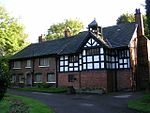Etihad Campus is an area of Sportcity, Manchester which is mostly owned and operated by Manchester City Football Club. The campus includes the Etihad Stadium, the City Football Academy (CFA) training facility and club world headquarters, and undeveloped land adjacent to both of these facilities. These two main portions of the campus site are linked by a 60-metre landmark pedestrian walkway/footbridge that spans the junction of Alan Turing Way and Ashton New Road. The term Etihad Campus embraces both the stadium – which already existed when the name was coined in 2010 – as well as much of the surrounding undeveloped land that existed at that time, although the term is also frequently used as a direct synonym for just the CFA portion.The development of the southeastern portion of the Etihad Campus site is focused on the regeneration of the Clayton Aniline site which consists of 80 acres of Brownfield land. The initial phase of the campus development included the construction of the new Manchester City training facility which was completed and officially opened in December 2014. Adjacent to the CFA facility is the Connell Sixth Form College – named after Anna Connell, the founder of St Mark's Gorton which later became Manchester City Football Club – which forms part of the Beswick Community Hub. The construction of the college was jointly funded by Manchester City F.C. and Manchester City Council and it opened to receive its first students in August 2013.The Beswick Community Hub is being developed on 16 acres of the 80-acre site originally purchased by the football club in order to develop its CFA facility, but like the footbridge linking the CFA to the Etihad Stadium, the club has donated this portion of its land purchase back to the local community so that it can be jointly developed with Manchester City Council to form a southern gateway approach to the completed Etihad Campus. Also part of the jointly funded and developed Beswick Community Hub, across from it on the western side of Alan Turing Way, is the new Beswick Leisure Centre. The construction of the leisure centre is also complete and it opened to the public in October 2014.Two further pieces that were jointly funded and developed were the Manchester Institute of Health and Performance (MIHP), currently under construction and for which the official opening is scheduled for early 2016, and beyond the completion of the MIHP there are plans to develop commercial office space, shops and retail opportunities on the northwestern side of the hub.The transformation of East Manchester forms a key part of the city's core development strategy for the Manchester region from 2012 to 2027, and likewise the scheme forms an integral part of Manchester City's aspiration to develop homegrown talent.In 2020, a 23,500 capacity indoor arena by Oak View Group was proposed adjacent to the stadium and which would be the largest in western Europe if built.
Work began on the Co-op Live in 2022.








